System Settings
Event Alerts
This feature allows you to enable and disable, as well as adjust the event alert settings (notification interval/frequency, event threshold, and type of notification) per severity level. This means that event alerts can be triggered with a more or less threshold sensitivity and more or less frequently (notification interval) so that you can manage the timeliness of notifications and the number of notifications received.
Each rule's severity will dictate which of the severity notification configurations will be applied to that rule.
If there is an error running the event notification task at the scheduled notification interval (such as events cannot be read from the event datastore) an error notification will be sent by the configured notification method.
The following parameters are individually configurable at each severity level:
- Enable/Disable
- Notification Interval
- Event Threshold
- Notification Methods (webhook, email)
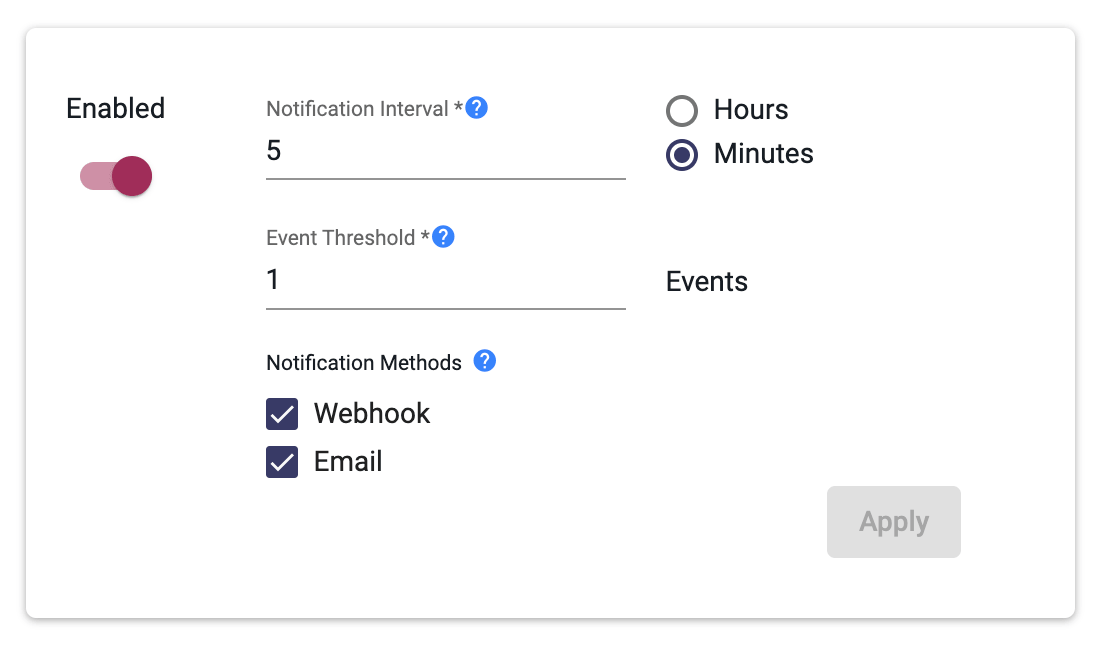
Enable/Disable:
This enables or disables the event notifications for each severity level. When disabled, no event notifications for that severity will be sent via email or webhook.
Notification Interval
This setting adjusts the time period during which a set event threshold will apply for each event severity.
Event Threshold
This sets the minimum number of events required to trigger a notification.
Examples
Example 1
- Low Severity is configured with a threshold of 10
- Low Severity is configured with a Notification Interval of 1 hour
- Rule A is configured with a Severity of Low
- Rule A triggers 8 times within 1 hour (the Notification Interval).
Because the threshold is 10 events within that hour, and only 8 are triggered, there will be no event notifications.
Example 2
- Low Severity is configured with a threshold of 10
- Low Severity is configured with a Notification Interval of 1 hour
- Rule A is configured with a Severity of Low
- Rule A triggers 12 times within 1 hour (the Notification Interval).
Because the threshold is 10 events within that hour, and 12 events are triggered (2 more than the Event Threshold), then 2 Event Notifications will be generated.
Note that the thresholds apply on a per rule basis. In the above Example 1, if Rule B were set with a severity of Low and it triggered 3 times within the same time interval that Rule A triggered 8 times, the Threshold is not met. It must be 10 times for each rule in order to trigger the notification: it is not an aggregate across all Low Severity rules.
Example 3
- Low Severity is configured with a Notification Interval of 1 hour
- The event datastore becomes unreachable
Since the events cannot be read to determine if an event notification should be sent, an error notification will be generated every hour (the Notification Interval). This error notification is intended to communicate that it cannot be determined if there are event notifications that should be sent. The error notification should not be relied on for monitoring event datastore availability. Should that be necessary, it is recommended specialist tools are used for that purpose.
Notification Methods
Webhooks and emails can be selected here. In this case, if either is selected, it will apply to the webhooks and emails that were set up above.
Webhooks
Webhooks provide a mechanism whereby a server-side application can notify a client-side application when a new event has occurred on the server.
Webhooks operate on the concept of event reaction, and thus avoids the need for constant polling of the server-side application by the client-side application. Thus, rather than the client-side application constantly polling the server-side application to check for new events, the server-side application calls the client-side application (by invoking a client-provided webhook URL) anytime the server-side has something new to report to the client. Thus, with webhooks, you can get push notifications when certain events happen on the server. You do not need to poll the API anymore to see if these events have happened. You can subscribe to an event with webhooks.
Set Up the Webhooks
- Click the Settings icon
 at the top-right corner of the main interface
at the top-right corner of the main interface - Select the System Settings from the pop-up menu
- Select the Webhooks tab
- Click the Add Webhook
- Fill in the required information for each field
- There is an option to Test Connection before completion
- Click Save to create the new Webhook
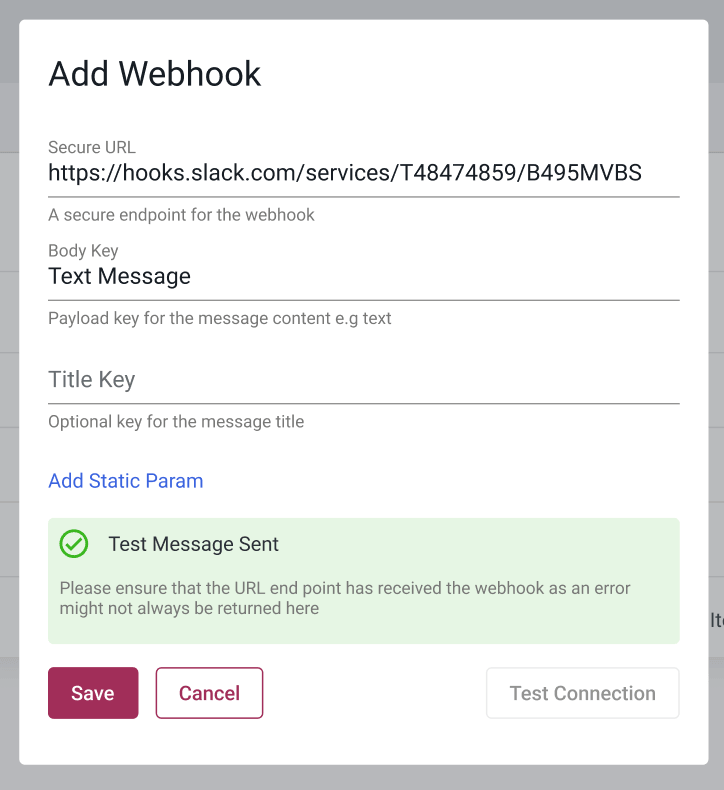
Event Storage
This page contains settings relating to events storage. This feature can be useful when you would prefer to only retain event data for a specific number of days. Once events have been deleted, they cannot be recovered.
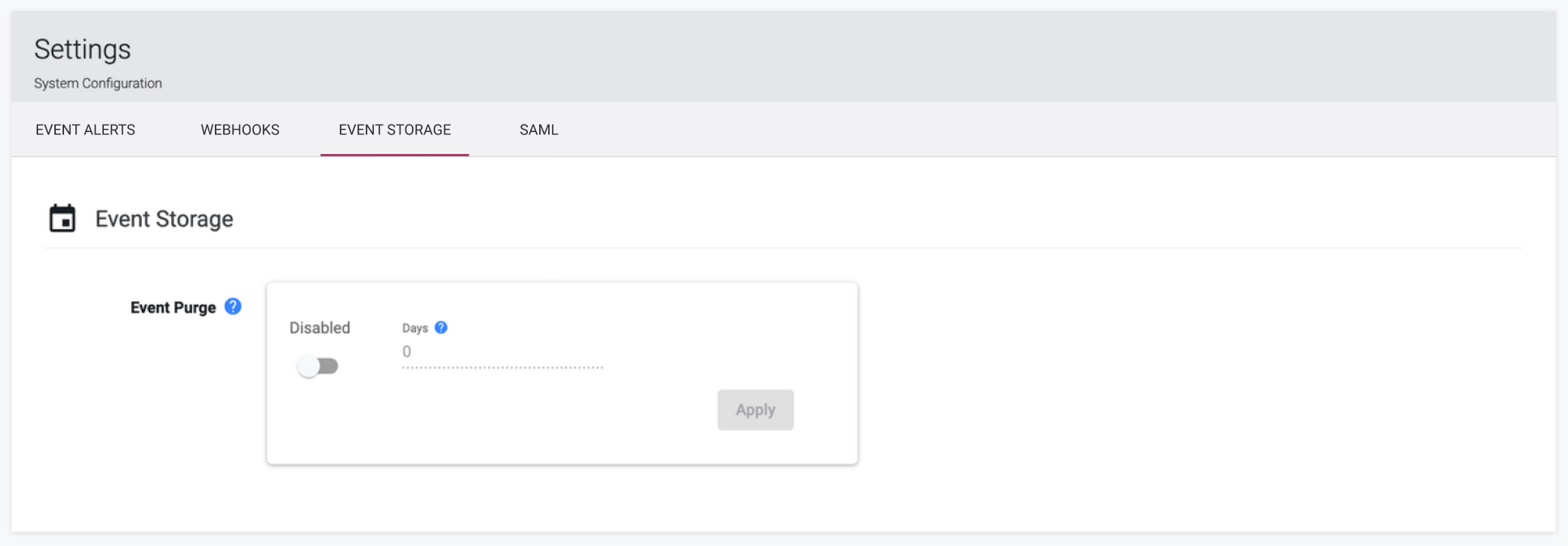
The event purging task runs every day at 4am local time by default. When the event purging setting is enabled and the task runs, events older than the number of days specified will be deleted.
Note that if 0 days is specified, only the current day's events will be preserved when the task runs. If the task runs at 4am then events between 12am and 4am will be preserved. All other events will be deleted.
If 1 day is specified, the current and previous day's events will be preserved. All other events will be deleted.
SAML
This section details the steps and settings required to integrate with SAML to provide Single Sign On (SSO).
How to Configure a SAML Identity Provider
Only one IdP (SAML Identity Provider) can be integrated with the Portal at any one time
Your IdP system can only be fully configured after the IdP has been linked to the Portal, but the Portal needs the IdP metadata in order to be fully configured. This is a chicken-egg kind of problem, which can be overcome using the steps below.
Steps
- In your IdP system, setup the SSO configuration with dummy values for the Entity Id and the Assertion Consumer Service, e.g.:
Entity Id:
https://portal.waratek.com/saml2/dummyAssertion Consumer Service:https://portal.waratek.com/saml2/sso/dummy - In your IdP system, export the provider metadata.
- In the Portal, add an identity provider using the SAML Identity Provider feature which is described below, using the exported provider metadata from Step 2.
- In the Portal, export the metadata using the SAML Identity Provider feature which is described below. This metadata will be different from the one you exported from your IDP system in Step 2.
- In your IdP system, update the SSO configuration with the correct Entity Id and the Assertion Consumer Service from the metadata exported in step 4, replacing “dummy” with the encoded provider ID. Or import the Portal metadata into the IdP.
The encoded Provider ID generated by the Portal will change every time an IdP is added to the Portal, so the corresponding value needs to be updated within the IdP each time.
SAML Identity Provider
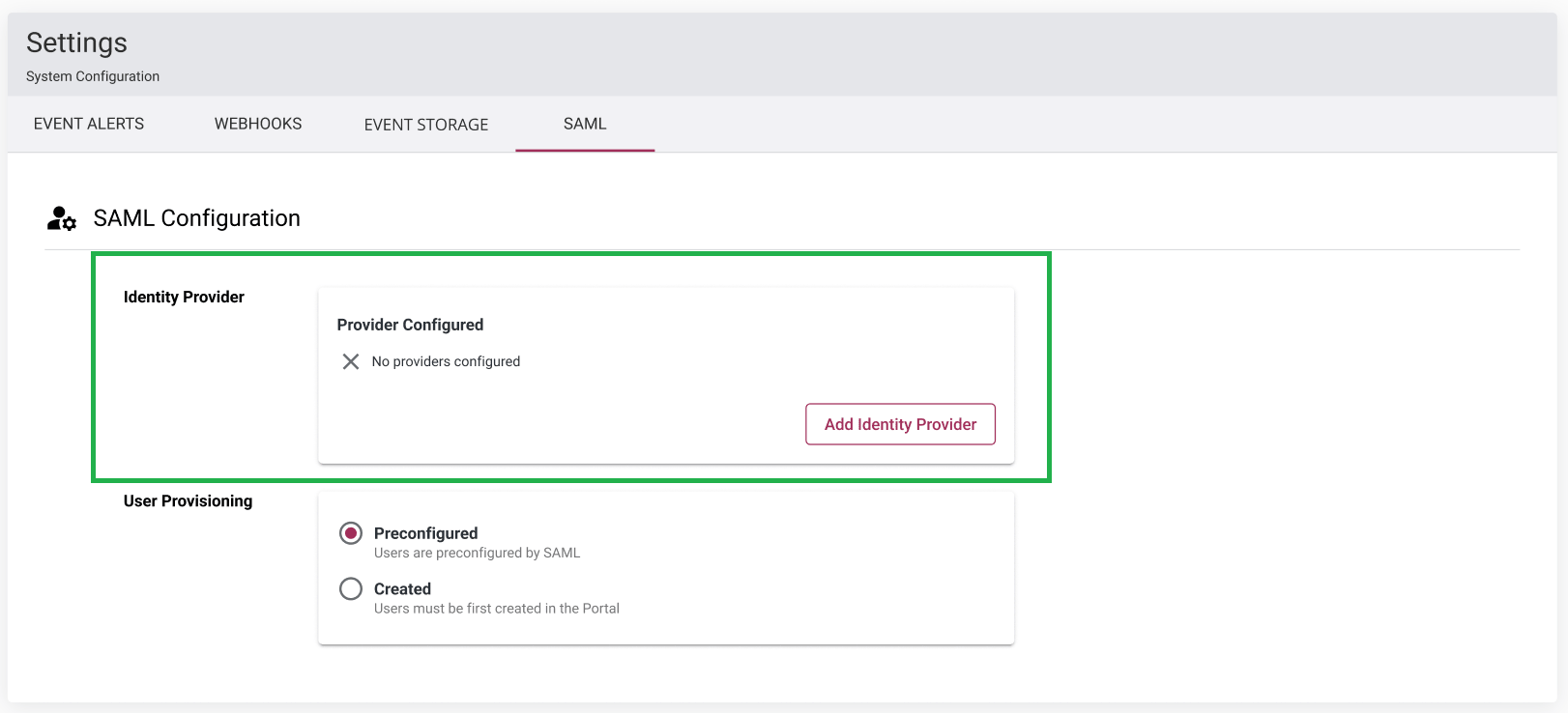
To add a SAML IdP to the Portal, click on the Add Identity Provider button, enter a name for the provider, upload the IdP metadata then click Save. Once this is done, the card will look as follows, containing the provider name, an enable/disable button, a delete button, and a button to export the metadata xml:
Once an IdP has been added, a Use Single Sign On button will appear on the Account Sign In page, which allows users of type “SAML” to log in via SSO:

User Provisioning
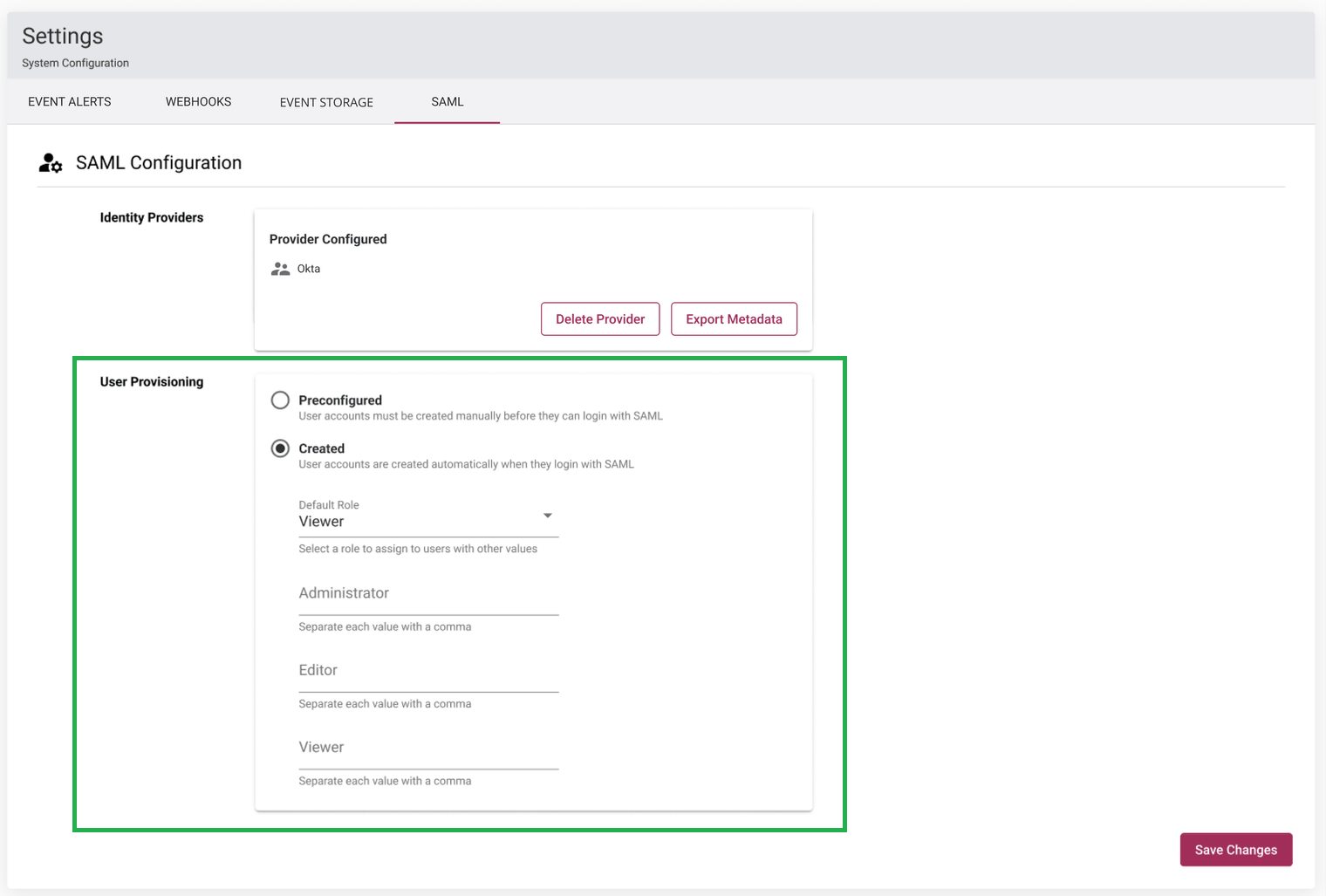
Only Portal Users with an Authentication Type of “SAML” can login using the SAML SSO.
There are 2 ways Users of this type can be created:
-
Preconfigured: An Admin manually creates each User account ahead of time, specifying SAML as the authentication type. See “User administration” section for more details.
-
Created: A User account will be automatically created the first time a User logs in successfully via SAML SSO. Extra configuration allows created accounts to be configured with a Role.
- The Default Role field specifies which role a user will have when they login via SSO.
- Additionally an optional SAML attribute named “userRole“ can be configured in the IdP and added to the SAML response to specify the Role that should be set for the User. The value of the attribute, per Role, should be set to ensure the correct Role mapping.
- Extra User fields can also be configured using SAML attributes:
| SAML Attribute Name | User Field |
|---|---|
| firstName | First Name |
| lastName | Last Name |
Note that details for “Created” Users in the Portal cannot be edited as the values come from the SAML response, and are updated if changed on every successful login.